Liwei Huang
Efficient Speech Command Recognition Leveraging Spiking Neural Network and Curriculum Learning-based Knowledge Distillation
Dec 17, 2024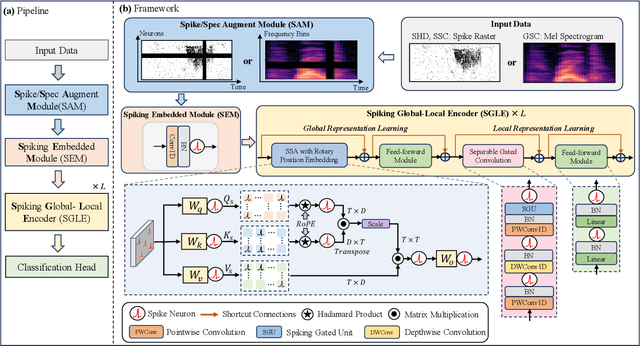
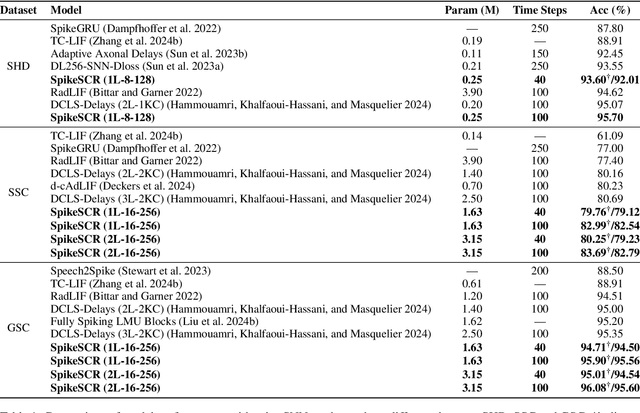
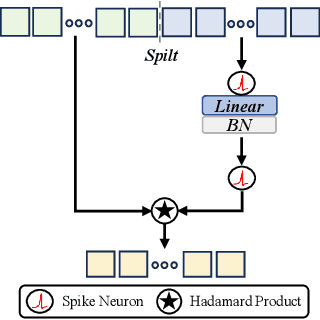

Abstract:The intrinsic dynamics and event-driven nature of spiking neural networks (SNNs) make them excel in processing temporal information by naturally utilizing embedded time sequences as time steps. Recent studies adopting this approach have demonstrated SNNs' effectiveness in speech command recognition, achieving high performance by employing large time steps for long time sequences. However, the large time steps lead to increased deployment burdens for edge computing applications. Thus, it is important to balance high performance and low energy consumption when detecting temporal patterns in edge devices. Our solution comprises two key components. 1). We propose a high-performance fully spike-driven framework termed SpikeSCR, characterized by a global-local hybrid structure for efficient representation learning, which exhibits long-term learning capabilities with extended time steps. 2). To further fully embrace low energy consumption, we propose an effective knowledge distillation method based on curriculum learning (KDCL), where valuable representations learned from the easy curriculum are progressively transferred to the hard curriculum with minor loss, striking a trade-off between power efficiency and high performance. We evaluate our method on three benchmark datasets: the Spiking Heidelberg Dataset (SHD), the Spiking Speech Commands (SSC), and the Google Speech Commands (GSC) V2. Our experimental results demonstrate that SpikeSCR outperforms current state-of-the-art (SOTA) methods across these three datasets with the same time steps. Furthermore, by executing KDCL, we reduce the number of time steps by 60% and decrease energy consumption by 54.8% while maintaining comparable performance to recent SOTA results. Therefore, this work offers valuable insights for tackling temporal processing challenges with long time sequences in edge neuromorphic computing systems.
Time-Dependent VAE for Building Latent Factor from Visual Neural Activity with Complex Dynamics
Aug 15, 2024



Abstract:Seeking high-quality neural latent representations to reveal the intrinsic correlation between neural activity and behavior or sensory stimulation has attracted much interest. Currently, some deep latent variable models rely on behavioral information (e.g., movement direction and position) as an aid to build expressive embeddings while being restricted by fixed time scales. Visual neural activity from passive viewing lacks clearly correlated behavior or task information, and high-dimensional visual stimulation leads to intricate neural dynamics. To cope with such conditions, we propose Time-Dependent SwapVAE, following the approach of separating content and style spaces in Swap-VAE, on the basis of which we introduce state variables to construct conditional distributions with temporal dependence for the above two spaces. Our model progressively generates latent variables along neural activity sequences, and we apply self-supervised contrastive learning to shape its latent space. In this way, it can effectively analyze complex neural dynamics from sequences of arbitrary length, even without task or behavioral data as auxiliary inputs. We compare TiDe-SwapVAE with alternative models on synthetic data and neural data from mouse visual cortex. The results show that our model not only accurately decodes complex visual stimuli but also extracts explicit temporal neural dynamics, demonstrating that it builds latent representations more relevant to visual stimulation.
SVFormer: A Direct Training Spiking Transformer for Efficient Video Action Recognition
Jun 21, 2024



Abstract:Video action recognition (VAR) plays crucial roles in various domains such as surveillance, healthcare, and industrial automation, making it highly significant for the society. Consequently, it has long been a research spot in the computer vision field. As artificial neural networks (ANNs) are flourishing, convolution neural networks (CNNs), including 2D-CNNs and 3D-CNNs, as well as variants of the vision transformer (ViT), have shown impressive performance on VAR. However, they usually demand huge computational cost due to the large data volume and heavy information redundancy introduced by the temporal dimension. To address this challenge, some researchers have turned to brain-inspired spiking neural networks (SNNs), such as recurrent SNNs and ANN-converted SNNs, leveraging their inherent temporal dynamics and energy efficiency. Yet, current SNNs for VAR also encounter limitations, such as nontrivial input preprocessing, intricate network construction/training, and the need for repetitive processing of the same video clip, hindering their practical deployment. In this study, we innovatively propose the directly trained SVFormer (Spiking Video transFormer) for VAR. SVFormer integrates local feature extraction, global self-attention, and the intrinsic dynamics, sparsity, and spike-driven nature of SNNs, to efficiently and effectively extract spatio-temporal features. We evaluate SVFormer on two RGB datasets (UCF101, NTU-RGBD60) and one neuromorphic dataset (DVS128-Gesture), demonstrating comparable performance to the mainstream models in a more efficient way. Notably, SVFormer achieves a top-1 accuracy of 84.03% with ultra-low power consumption (21 mJ/video) on UCF101, which is state-of-the-art among directly trained deep SNNs, showcasing significant advantages over prior models.
Direct Training High-Performance Deep Spiking Neural Networks: A Review of Theories and Methods
May 06, 2024



Abstract:Spiking neural networks (SNNs) offer a promising energy-efficient alternative to artificial neural networks (ANNs), in virtue of their high biological plausibility, rich spatial-temporal dynamics, and event-driven computation. The direct training algorithms based on the surrogate gradient method provide sufficient flexibility to design novel SNN architectures and explore the spatial-temporal dynamics of SNNs. According to previous studies, the performance of models is highly dependent on their sizes. Recently, direct training deep SNNs have achieved great progress on both neuromorphic datasets and large-scale static datasets. Notably, transformer-based SNNs show comparable performance with their ANN counterparts. In this paper, we provide a new perspective to summarize the theories and methods for training deep SNNs with high performance in a systematic and comprehensive way, including theory fundamentals, spiking neuron models, advanced SNN models and residual architectures, software frameworks and neuromorphic hardware, applications, and future trends. The reviewed papers are collected at https://github.com/zhouchenlin2096/Awesome-Spiking-Neural-Networks
QKFormer: Hierarchical Spiking Transformer using Q-K Attention
Mar 25, 2024



Abstract:Spiking Transformers, which integrate Spiking Neural Networks (SNNs) with Transformer architectures, have attracted significant attention due to their potential for energy efficiency and high performance. However, existing models in this domain still suffer from suboptimal performance. We introduce several innovations to improve the performance: i) We propose a novel spike-form Q-K attention mechanism, tailored for SNNs, which efficiently models the importance of token or channel dimensions through binary vectors with linear complexity. ii) We incorporate the hierarchical structure, which significantly benefits the performance of both the brain and artificial neural networks, into spiking transformers to obtain multi-scale spiking representation. iii) We design a versatile and powerful patch embedding module with a deformed shortcut specifically for spiking transformers. Together, we develop QKFormer, a hierarchical spiking transformer based on Q-K attention with direct training. QKFormer shows significantly superior performance over existing state-of-the-art SNN models on various mainstream datasets. Notably, with comparable size to Spikformer (66.34 M, 74.81%), QKFormer (64.96 M) achieves a groundbreaking top-1 accuracy of 85.65% on ImageNet-1k, substantially outperforming Spikformer by 10.84%. To our best knowledge, this is the first time that directly training SNNs have exceeded 85% accuracy on ImageNet-1K. The code and models are publicly available at https://github.com/zhouchenlin2096/QKFormer
SpikingJelly: An open-source machine learning infrastructure platform for spike-based intelligence
Oct 25, 2023Abstract:Spiking neural networks (SNNs) aim to realize brain-inspired intelligence on neuromorphic chips with high energy efficiency by introducing neural dynamics and spike properties. As the emerging spiking deep learning paradigm attracts increasing interest, traditional programming frameworks cannot meet the demands of the automatic differentiation, parallel computation acceleration, and high integration of processing neuromorphic datasets and deployment. In this work, we present the SpikingJelly framework to address the aforementioned dilemma. We contribute a full-stack toolkit for pre-processing neuromorphic datasets, building deep SNNs, optimizing their parameters, and deploying SNNs on neuromorphic chips. Compared to existing methods, the training of deep SNNs can be accelerated $11\times$, and the superior extensibility and flexibility of SpikingJelly enable users to accelerate custom models at low costs through multilevel inheritance and semiautomatic code generation. SpikingJelly paves the way for synthesizing truly energy-efficient SNN-based machine intelligence systems, which will enrich the ecology of neuromorphic computing.
Deep recurrent spiking neural networks capture both static and dynamic representations of the visual cortex under movie stimuli
Jun 02, 2023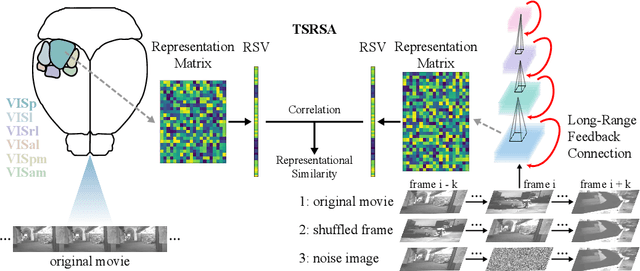

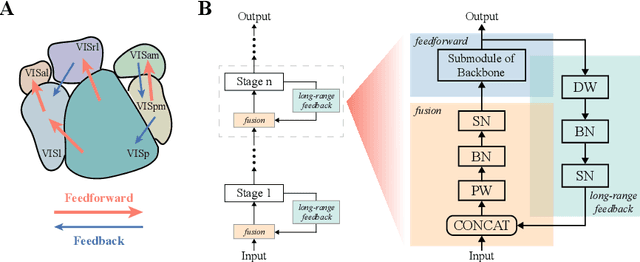

Abstract:In the real world, visual stimuli received by the biological visual system are predominantly dynamic rather than static. A better understanding of how the visual cortex represents movie stimuli could provide deeper insight into the information processing mechanisms of the visual system. Although some progress has been made in modeling neural responses to natural movies with deep neural networks, the visual representations of static and dynamic information under such time-series visual stimuli remain to be further explored. In this work, considering abundant recurrent connections in the mouse visual system, we design a recurrent module based on the hierarchy of the mouse cortex and add it into Deep Spiking Neural Networks, which have been demonstrated to be a more compelling computational model for the visual cortex. Using Time-Series Representational Similarity Analysis, we measure the representational similarity between networks and mouse cortical regions under natural movie stimuli. Subsequently, we conduct a comparison of the representational similarity across recurrent/feedforward networks and image/video training tasks. Trained on the video action recognition task, recurrent SNN achieves the highest representational similarity and significantly outperforms feedforward SNN trained on the same task by 15% and the recurrent SNN trained on the image classification task by 8%. We investigate how static and dynamic representations of SNNs influence the similarity, as a way to explain the importance of these two forms of representations in biological neural coding. Taken together, our work is the first to apply deep recurrent SNNs to model the mouse visual cortex under movie stimuli and we establish that these networks are competent to capture both static and dynamic representations and make contributions to understanding the movie information processing mechanisms of the visual cortex.
Deep Spiking Neural Networks with High Representation Similarity Model Visual Pathways of Macaque and Mouse
Mar 09, 2023



Abstract:Deep artificial neural networks (ANNs) play a major role in modeling the visual pathways of primate and rodent. However, they highly simplify the computational properties of neurons compared to their biological counterparts. Instead, Spiking Neural Networks (SNNs) are more biologically plausible models since spiking neurons encode information with time sequences of spikes, just like biological neurons do. However, there is a lack of studies on visual pathways with deep SNNs models. In this study, we model the visual cortex with deep SNNs for the first time, and also with a wide range of state-of-the-art deep CNNs and ViTs for comparison. Using three similarity metrics, we conduct neural representation similarity experiments on three neural datasets collected from two species under three types of stimuli. Based on extensive similarity analyses, we further investigate the functional hierarchy and mechanisms across species. Almost all similarity scores of SNNs are higher than their counterparts of CNNs with an average of 6.6%. Depths of the layers with the highest similarity scores exhibit little differences across mouse cortical regions, but vary significantly across macaque regions, suggesting that the visual processing structure of mice is more regionally homogeneous than that of macaques. Besides, the multi-branch structures observed in some top mouse brain-like neural networks provide computational evidence of parallel processing streams in mice, and the different performance in fitting macaque neural representations under different stimuli exhibits the functional specialization of information processing in macaques. Taken together, our study demonstrates that SNNs could serve as promising candidates to better model and explain the functional hierarchy and mechanisms of the visual system.
Position-enhanced and Time-aware Graph Convolutional Network for Sequential Recommendations
Jul 12, 2021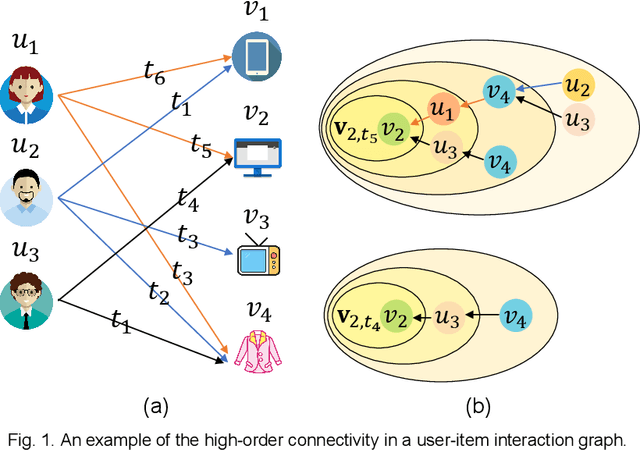
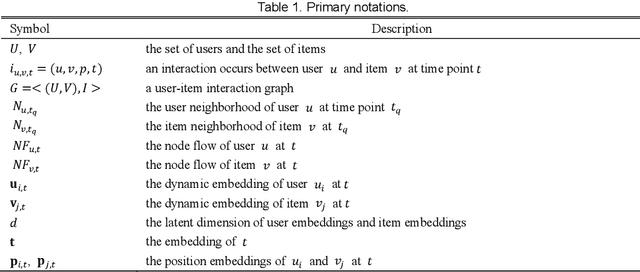
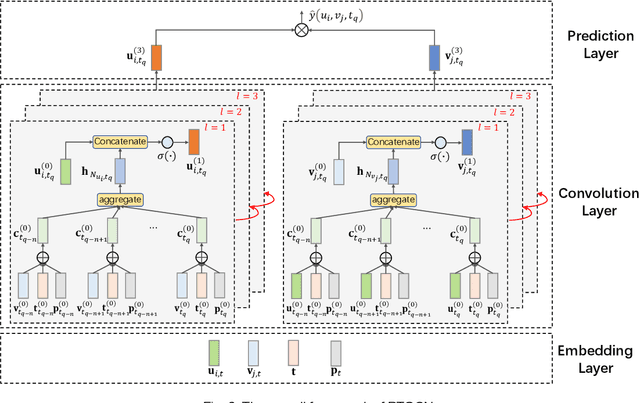

Abstract:Most of the existing deep learning-based sequential recommendation approaches utilize the recurrent neural network architecture or self-attention to model the sequential patterns and temporal influence among a user's historical behavior and learn the user's preference at a specific time. However, these methods have two main drawbacks. First, they focus on modeling users' dynamic states from a user-centric perspective and always neglect the dynamics of items over time. Second, most of them deal with only the first-order user-item interactions and do not consider the high-order connectivity between users and items, which has recently been proved helpful for the sequential recommendation. To address the above problems, in this article, we attempt to model user-item interactions by a bipartite graph structure and propose a new recommendation approach based on a Position-enhanced and Time-aware Graph Convolutional Network (PTGCN) for the sequential recommendation. PTGCN models the sequential patterns and temporal dynamics between user-item interactions by defining a position-enhanced and time-aware graph convolution operation and learning the dynamic representations of users and items simultaneously on the bipartite graph with a self-attention aggregator. Also, it realizes the high-order connectivity between users and items by stacking multi-layer graph convolutions. To demonstrate the effectiveness of PTGCN, we carried out a comprehensive evaluation of PTGCN on three real-world datasets of different sizes compared with a few competitive baselines. Experimental results indicate that PTGCN outperforms several state-of-the-art models in terms of two commonly-used evaluation metrics for ranking.
 Add to Chrome
Add to Chrome Add to Firefox
Add to Firefox Add to Edge
Add to Edge